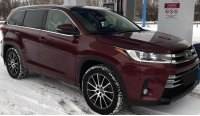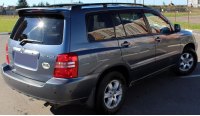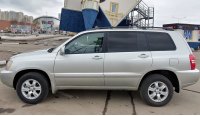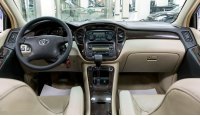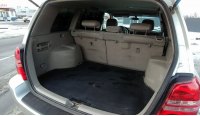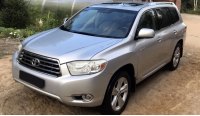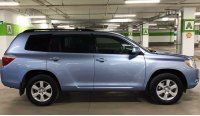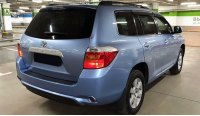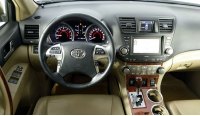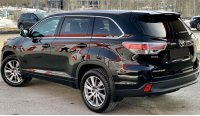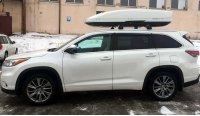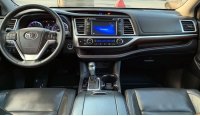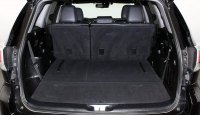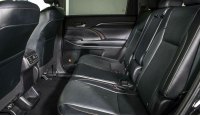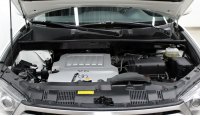Share information:
Currently, Highlander's main classmates and competitors are Audi Q5, BMW X3, Chevrolet Tahoe, Dodge Journey, Ford Explorer, Honda Pilot, Hyundai Santa Fe, Kia Sorento, Infiniti QX80, Lexus GX, Mazda CX-9, Land Rover Discovery, Mitsubishi Pajero, Nissan Patrol, Nissan Pathfinder, Peugeot 5008, Porsche Cayenne, Suzuki Grand Vitara, Toyota Land Cruiser Prado, Volvo XC90 and Volkswagen Touareg.
First generation (XU20, 2000-2007)
The first generation was introduced in April 2000 at the New York International Auto Show. In Japan, the car went on sale at the end of 2000, and was exported in January 2001. Carrying body with five or seven seats for passengers in the cabin. The length was 4681-4689 mm, width 1826 mm, height 1679-1745 mm and curb weight 1716 kg. In the initial configuration, the car is only with front-wheel drive, there is also all-wheel drive with a fixed 50:50 torque distribution. Thanks to the independent suspension, road comfort is higher than that of a similar class and size «4Runner». Complete sets in the USA were called «Base», «Sport» and «Limited».
Engines were installed only gasoline, one four-cylinder with a volume of 2.4 liters (2362 cm3, 2AZ-FE, I4, 155 hp) and two six-cylinder V-shaped 3.0-liter (2994 cm3, 1MZ-FE, V6, 200 hp) and 3.3 liters (3310 cm3, 3MZ-FE, V6, 225 hp). The gearbox was a four-speed automatic (U140E/U140F/U241E) or five-speed manual (U151E/U151F).
Anti-lock brakes were standard (ABS), brake assist and electronic brake force distribution. Stability control, traction control and a tire pressure monitor were offered as options and later became standard on all models.
In 2001, there was the first update related to the instrument panel and center console. In 2003, the model was updated. Changes were made to the wheels, grille, both bumpers, headlights and taillights. A third row of seats appeared, making the car seven-seater. In 2005, some models underwent a third update.
American agency «National Highway Traffic Safety Administration» (NHTSA) conducted crash tests on 2002 and 2004 vehicles without side airbags. Test results in 2002:
- frontal impact (driver) — 4 out of 5 stars
- frontal impact (passenger) — 4 out of 5 stars
- Side kick (driver) — 4 out of 5 stars
- Side kick (rear passenger) — 5 out of 5 stars
- Roof strength - 3 out of 5 stars
Test results in 2004:
- frontal impact (driver) — 5 out of 5 stars
- frontal impact (passenger) — 5 out of 5 stars
- Side kick (driver) — 5 out of 5 stars
- Side kick (rear passenger) — 5 out of 5 stars
- Roof strength - 4 out of 5 stars
In the crash tests of the American «Institute of Road Safety» (IIHS) car has been rated «Fine» in a frontal offset impact.
In 2005, a hybrid version of the crossover appeared with the name «Kluger Hybrid» or «Highlander Hybrid» (MHU28) with 3.3 liter engine (3310 cm3, 3MZ-FE, V6, 225 hp) front or all wheel drive. The average fuel consumption was 8.4-9.4 liters per 100 km.
Second generation (XU40, 2007-2013)
Second generation Highlander with code «XU40» was shown at the Chicago Auto Show in February 2007. Sales of the regular version began in July, and the hybrid version in September 2007. The length of the car was 4785 mm, width 1910-1917 mm, height 1729-1760 mm and curb weight 1835 kg, that is, the dimensions increased in all three dimensions, and this, plus an increase in sound insulation, led to an increase in mass. The trim levels were called the same as the first generation - «Base», «Sport» and «Limited». All-wheel drive or front-wheel drive only. The steering became electrically boosted. Production was carried out in Japan, China and the USA.
Ordinary cars were equipped only with 2.7-liter gasoline engines (2672 cm3, 1AR-FE, I4, 187 hp) and 3.5 liters (3456 cm3, 2GR-FE, V6, 268 hp). The gearbox was a five- or six-speed automatic (U151E, U760E). Hybrid models were equipped with 3.3-liter six-cylinder V-engines (3310 cm3, 3MZ-FE, V6, 225 hp) and 3.5 liters (3456 cm3, 2GR-FXE, V6, 245 hp).
The model was updated in 2010. The front part was seriously redesigned, new headlights and a radiator grille were installed.
American «Road Safety Institute» (IIHS) crash tested the Highlander in a partial overlap frontal collision and scored «Fine» in all categories except «Head/neck», where the score turned out «acceptable». Side impact rated «Fine» in all categories. In 2008 the American agency «National Highway Traffic Safety Administration» (NHTSA) conducted its crash tests to understand how safe the car is for people. The results are as follows:
- frontal impact (driver) — 5 out of 5 stars
- frontal impact (passenger) — 4 out of 5 stars
- Side kick (driver) — 5 out of 5 stars
- Side kick (rear passenger) — 5 out of 5 stars
- Roof strength - 4 out of 5 stars
Vehicle safety is ensured by the following standard features - vehicle stability control, which immediately changes the electric power steering, traction control, anti-lock brakes, brake assist with electronic brake force distribution, hill start anti-rollback. Also standard are tire pressure sensors, a driver's knee airbag, side airbags in the front seats, side curtain airbags for all three rows of seats that include a rollover sensor, and active headrests in the front seats.
Third generation (XU50, 2013-present time)
At the New York Auto Show in March 2013, the third generation was presented «highlander», launched in December 2013. Based on the same platform «Toyota K». The exterior design has been pretty heavily redesigned. The length of the car was 4854 mm, width 1925 mm, height 1730 mm and curb weight 2045 kg. The external dimensions have again increased compared to its predecessor, and the weight has increased by 200 kg. For the first time, models with eight seats appeared. The materials and quality of interior trim have improved. Production was carried out in China and the USA.
Engines installed only gasoline of the following characteristics:
- 2.0 liters (1998 cm3, 8AR-FTS, I4, turbo) 235 hp
- 2.7 liters (2672 cm3, 1AR-FE, I4) 187 hp
- 3.5 liters (3456 cm3, 2GR-FE, V6) 268 hp
- 3.5 liters (3456 cm3, 2GR-FXE, V6, hybrid) 245 hp
- 3.5 liters (3456 cm3, 2GR-FKS, V6) 278 hp
The gearbox was used only automatic - six-speed «U660E/U760E» or eight-speed «UA80E/UA80F».
Lane Departure Warning, Collision Warning, Blind Spot Monitoring, «HD Radio», «Bluetooth», multimedia system «Toyota Entune» and an audio system with a 6.1-inch touch screen.
The update was carried out in 2017 with the car being shown at the New York Auto Show in March 2016. External changes affected the headlights, taillights and new exterior and interior colors.
2016 Car of the Year Crash Tested by US Agency «National Highway Traffic Safety Administration» (NHTSA), the results of which are as follows:
- Overall rating - 5 out of 5 stars
- frontal impact (driver) — 4 out of 5 stars
- frontal impact (passenger) — 5 out of 5 stars
- Side kick (driver) — 5 out of 5 stars
- Side kick (rear passenger) — 5 out of 5 stars
- Roof strength - 4 out of 5 stars

